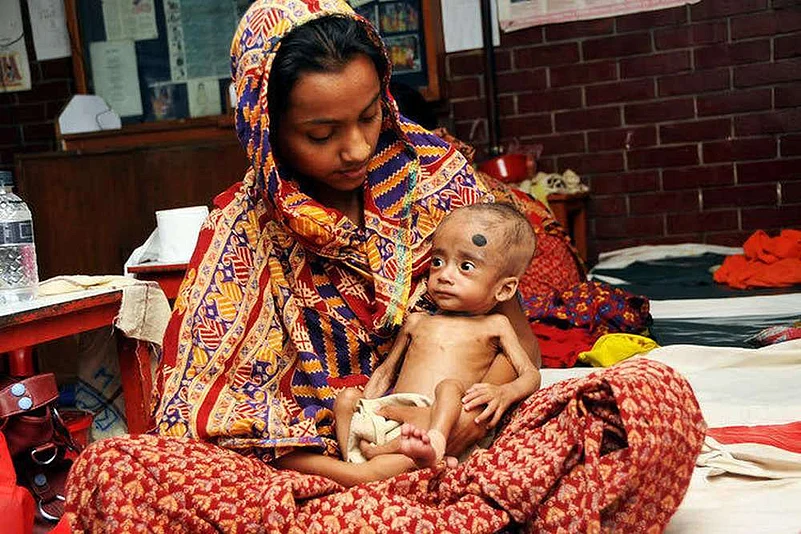At nine months, Shanno weighed a paltry 2.8 kgs. When she was brought to our OPD at the hospital, she was suffering from recurrent loose motions and excoriation around the anus. We observed that not just her weight, but her linear growth was also slow. In addition, she displayed symptoms of irritability, apathy, decreased social responsiveness, anxiety, and attention deficit.
Fighting Severe Acute Malnutrition In India's Uttar Pradesh
POSHAN Maah 2020 has been dedicated to SAM children and their management with the theme, 'Kuposhit bacchon ki pehchan evam unki tracking'

Shanno’s parents were labourers. While examining her, I found ulcers over the angle of her mouth and discovered that the child was anaemic and suffered from Severe and Acute Malnutrition (SAM). A conversation with her parents proved to be revealing.
Since her parents had to go out to earn a livelihood, Shanno’s caregiver was her eight-year old sister. The baby was being bottle fed with arrowroot powder mixed in water throughout the day. Complementary feeding had not been introduced even after she turned nine-months old.
Unfortunately, Shanno is not a lone case. As per World Health Organization data, 19 million children under the age of five years around the world suffer from SAM. (SAM) is defined by very low weight-for-height / length (Z score below - 3 SD), visible severe wasting and presence of nutritional edema. As per NFHS-4 (2015-2016) data, about 7.5% of the children under five years of age are severely wasted (weight-for-height). Uttar Pradesh alone has an estimated 1.2 lakh SAM cases that may require medical treatment.
SAM can lead from slightly aggravated to acute symptoms in children, making them susceptible to acute diarrhoea, pneumonia, hypoglycemia and anaemia, to name a few. It also leads to growth retardation and underdeveloped IQs leading to learning disorders.
In most cases, inadequate food intake and cessation of early breastfeeding form the second largest cause of SAM in children, with poverty being the first.
While the government and development partners have come together to initiate several interventions to reduce SAM, occasions such as POSHAN Maah serve as significant reminders for the need to intensify the efforts to reiterate our commitment towards improving maternal and child nutrition.
Due to its far-reaching intergenerational impact and long-term socio-economic repercussions, POSHAN Maah 2020 has been dedicated to SAM children and their management with the theme, Kuposhit bacchon ki pehchan evam unki tracking (Identification of SAM children and their tracking), combined with a drive to promote POSHAN Vatika or Nutri-garden in households so that families can have easy access to nutrient-rich food.
The scope of POSHAN Maah 2020 makes provisions for door-to-door visits, collecting data on SAM children from mothers, dedicated childlines, hospitals and the POSHAN app. In probable cases of SAM, a medical examination by a doctor will be followed by home management or hospitalization depending on the severity of the medical complications.
In India, Anganwadi Workers (AWWs) are closely associated with SAM management. An AWW visits mothers of SAM children once every week and counsels them on nutrition, correct feeding practices, available public services, and local officials they can contact when needed. During the home visits, AWWs also explain the significance of growth monitoring and how to identify symptoms of malnutrition to mothers and caregivers.
In addition to counselling services by AWW, there is a network of 77 nutritional rehabilitation centres (NRCs) which offer clinical care to approximately 18,000 wasted children in the country.
Unlike other states, Uttar Pradesh did not have a Tertiary Centre for care and management of SAM children for quite some time. Hence, a State Technical Advisory Unit (STAU) for Severe and Acute Malnutrition in Children has been formed at Sanjay Gandhi Postgraduate Institute of Medical Sciences, Lucknow (SGPGIMS) to fulfill a long felt gap for a technical resource center for managing SAM cases with severe afflictions and connect the network of NRCs with dedicated state driven technical pool of experts. This unit is also engaged in advising the policymakers and senior health program managers on clinical management of 90% wasted children who cannot reach the NRCs.
I sincerely hope that SGPGIMS in collaboration with UNICEF & National Health Mission will help in leveraging knowledge and skills for saving lives of several young children and ensuring a better future for them.
(views are personal)
(The author is a DCH, MD(Pediatrics), Fellow Indian Academy of Pediatrics (FIAP), Fellow Royal College of Physicians (FRCP), London, Senior Pediatrician, General Hospital, Sanjay Gandhi Postgraduate Institute of Medical Sciences, Nodal Officer for State Technical Advisory Unit on SAM, U.P)
-
Previous Story
 Priyanka Chopra Says Guneet Monga's 'The Elephant Whisperers' Is A Trunk-Filled With Emotions
Priyanka Chopra Says Guneet Monga's 'The Elephant Whisperers' Is A Trunk-Filled With Emotions - Next Story


















